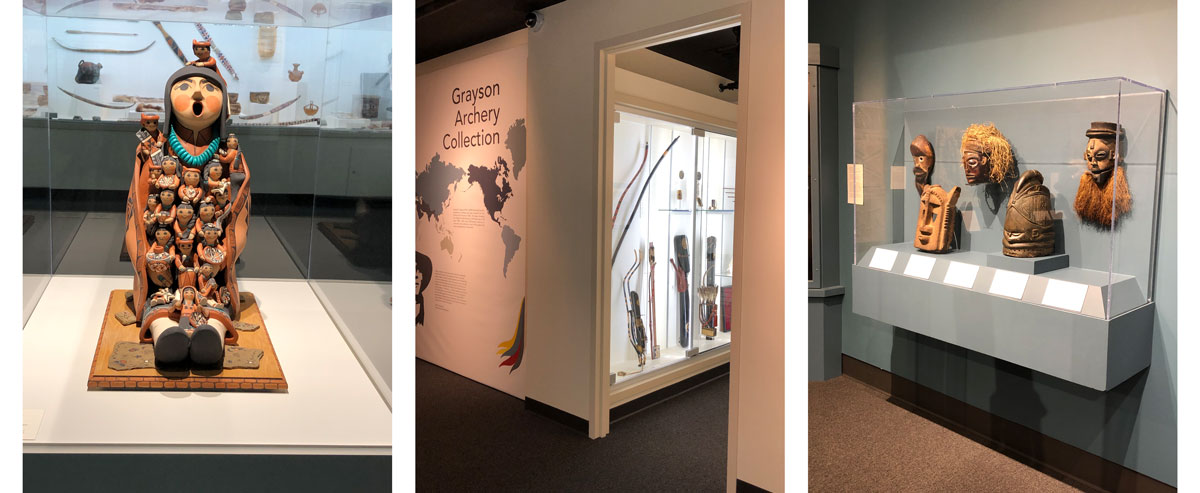This article originally appeared in the March 2021 issue
A crisscross trip through Missouri reveals a menagerie of museums and oddities, repositories of relics unique to local history and communities. In Memphis, Missouri, just 15 minutes from the Iowa border, the 14-room Downing House Museum has a life-size representation of Ella Ewing, Missouri’s “Gentle Giantess,” who stood eight feet, four inches tall. About 120 miles to the southwest in Chillicothe, the Grand River Historical Society Museum has the original sliced bread machine. Just 60 miles to the east in Marshall is the Nicholas-Beazley Aviation Museum and a pilot license signed by Orville Wright.
Continuing east to Gasconade, near Hermann, is perhaps the largest private museum item on display in the state: the USS Aries Hydrofoil—a watercraft that flies above the water—at 250 tons and 133 feet long. The USS Aries Hydrofoil Museum is an outdoor venue at the confluence of the Gasconade and Missouri rivers. At nearby Villa Ridge, the Boles Fire History Museum features Civil War-era fire buggies along with surgical instruments from that war. The museum’s curator is eager to share that history with school kids.
Turning west, Tom Gasko is ready to show his collection of 550 vacuum cleaners, a lifetime in the making, at the Mid-Missouri Vacuum Museum in Rolla. Just shy of 200 miles farther along I-44 is the National Cookie Cutter Museum in Joplin. Head east 310 miles to cross the state to Jackson to find a gem hiding in plain sight: the visitors center at Trail of Tears State Park, just one example of extraordinary displays at state parks, historic sites, and conservation nature centers.
This museum musing concludes with a 105-mile drive due south to Kennett, just four miles from the Arkansas border, for a look at circa 1800s prescriptions for opium and cocaine at Mitchell Pharmacy Museum. You’ll also see the 120-year-old death warrant for the last public hanging in Kennett.
The circuitous Memphis to Kennett trip—via Chillicothe, Marshall, Gasconade, Villa Ridge, Rolla, Joplin, and Jackson—spans a little over 1,000 miles. With ample pit stops for down-home cafes and diners, cozy bed-and-breakfasts, antique malls, and farmer’s markets, this could take a while.
Downing House Museum
311 S. Main St., Memphis • 660-465-2259 • Open April through Labor Day, 1‒4 pm, Tuesdays–Thursdays or by appointment • $5 for adults and children 10 and older • DowningHouseMuseum.org

Eighteen years before Ella Ewing died of tuberculosis in 1913, her mother wrote that Ella had finally stopped growing. Ella’s official height is not well documented. The Guinness Book of World Records 2015 edition says Missouri’s “Gentle Giantess” was seven foot four or seven foot six, though other accounts claim she was at least eight feet tall.
A life-size model of Ella is just one feature of the Downing House Museum Complex in Memphis, 40 miles northeast of Kirksville. Ella, who suffered from pituitary gigantism, grew up outside nearby Gorin in Scotland County, where she is buried. As an attraction for the Ringling Bros. and Barnum & Bailey Circus, she was billed as “Earth’s tallest woman.”
The Ella Ewing Room at Downing House has a vast collection of Ella’s belongings, from her iron bed and size-24 shoes to clothes and an abundance of photographs and newspaper articles. But there’s far more to see in the museum, a 14-room brick mansion that the Scotland County Historical Society purchased in 1978.
“You can spend hours there. It’s hard to even give a tour and get it all covered,” says museum co-curator Rhonda McBee. “Every time I give a tour, I see something I didn’t know was there.”
Union officers commandeered the house for a Civil War headquarters, and prisoners have been kept there. The museum is a complex of buildings that includes the Boyer House, the old Memphis depot for the Keokuk and Western Railroad, and a World War I memorial statue, among other features. There’s also a second-floor antique barbershop, a room dedicated to the physician who practiced in the building from 1908 through 1930, relics from the now-shuttered Gorin school, and a child’s toy room with antique toys and furniture.
Nicholas-Beazley Aviation Museum
1985 S. Odell Ave., Marshall • 660-886-2630 • Open 10 am‒4 pm Tuesdays–Saturdays or by appointment • Adults $10; children 12 and under $5 • NicholasBeazley.org
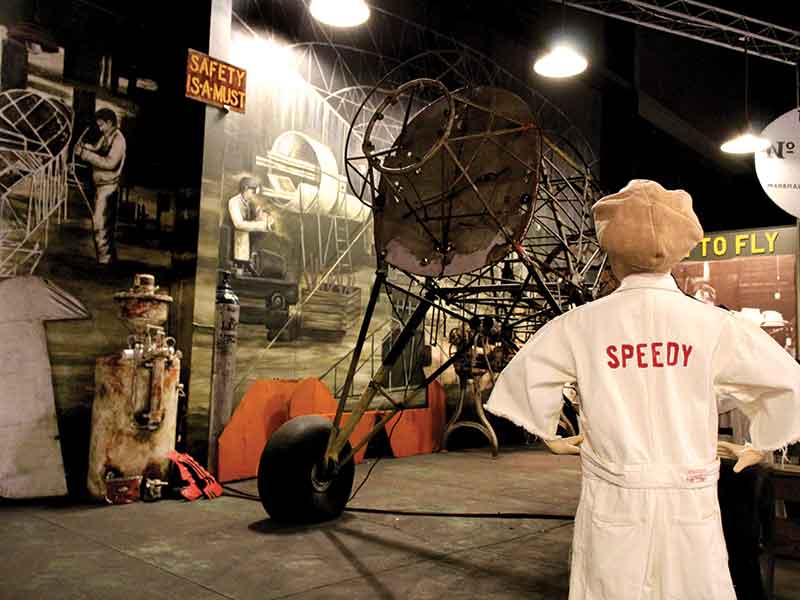
When Charles Lindbergh’s Spirit of St. Louis crossed the Atlantic in 1927, some of the pieces that held the sturdy little monoplane together came from the Nicholas-Beazley Airline Co. of Marshall. The Nicholas-Beazley Aviation Museum in Marshall, just an hour’s drive west of Columbia or about an hour-and-a-half east of Kansas City, pays tribute to the town’s connection with the early days of aviation.
Among the notable artifacts, which include full-size airplanes, is Nicholas’s pilot’s license, signed by aviation pioneer Orville Wright on January 21, 1929.
“We really like that little piece,” says Shannon Nichols, executive manager for Martin Community Center, which houses the aviation museum. Exhibits include two of the five remaining NB8 two-seat airplanes built in the 1930s, which had wood wing ribs and the ability for the wings to fold back to be towed by a car.
“These were aircrafts they made in Marshall,” Shannon says. The collection includes the one-person Flying Flea. “If you see it, you go, ‘I would never fly that,’” Shannon says.
Visitors can also glimpse a rare 1941 T-6 glider that was found in a basement in Slater. The glider had been modified with an engine but was restored to pre-World War II condition, with no engine, and is flyable, according to Shannon. Only three remain of the 750 that were manufactured.
The Nicholas-Beazley Aviation Museum also has a flight simulator and an interactive area where children can learn the fundamentals of how planes work.
BOLES FIRE HISTORY MUSEUM
465 Highway M, Villa Ridge • 314-795-2826 • Open by appointment • Free • Facebook: Boles Fire History Museum
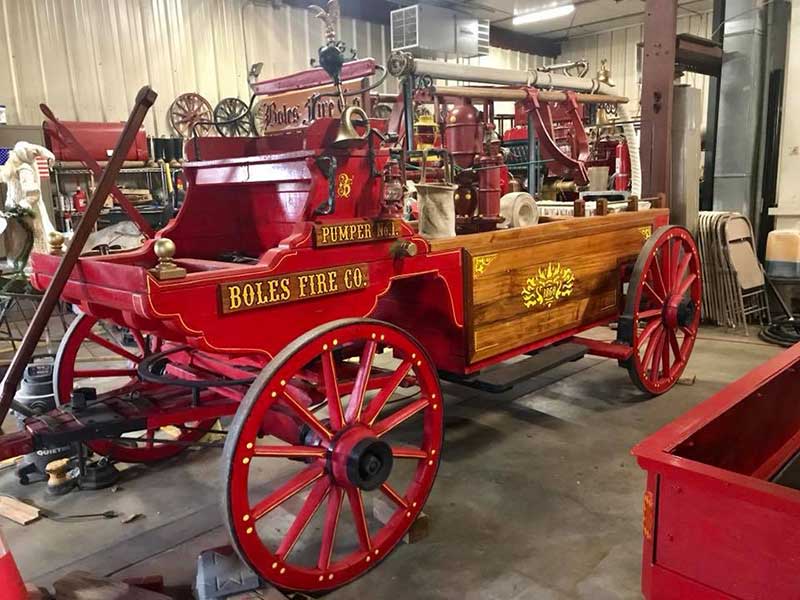
The 1918 American LaFrance fire truck with a hand-cranked siren was one of the first motorized fire rigs to have a four-cylinder internal combustion engine. But it was almost reduced to rust and ashes.
“The owner was going to burn it,” Boles Fire History Museum Curator Charles Staats says. A friend spotted the old truck in the middle of a field and alerted Charles to the vehicle’s impending doom.
“It’s my pride and joy. It took me ten years to restore it. Every nut, bolt, and washer. If it could be saved, we saved it,” Charles says.
The museum is forty-five miles west of St. Louis in Franklin County. The collection of fire vehicles and equipment pay tribute to the Boles Fire District and the history of firefighting. There are also two antique horse-drawn sleds and some equipment and buggies that date back to the Civil War, including an 1860, eight-man fire pumper.
“There is a story with every piece of equipment,” Charles says. And he’s eager to share them with school children and kids who can sit in the buggies and climb on some of the equipment. Charles, who is an expert at starting conversations, also points out that his last name is a palindrome and that the museum also houses his extensive collection of surgical instruments from the Civil War.
At eighty-four, Charles is a retired liturgical artist. He made stained glass windows, mosaics, ceramics, and wood carvings for churches.
“I’ve done everything I wanted to do in life, and now it’s time to share everything with other people, especially children,” he says.
According to Charles, operating hours are “whenever I’m there” and by calling for an appointment. Admission is free, but visitors might see a little jar marked “donations.”
MITCHELL PHARMACY MUSEUM
100 College Ave., Kennett • 870-740-0383 • Open by appointment

The contents of seven drugstores, most of them old country drugstores, and an array of other historical relics is how Keith Mitchell describes Mitchell Pharmacy Museum in the Bootheel, just a stone’s throw from the Arkansas line.
The collection includes prescriptions from the 1800s, some for opium, cocaine, and “all the old chemicals,” Keith says. “People bring it to me; I bought some of it. It’s an accumulation over the years, so there’s a bunch of junk down here. But I’ve always been interested in that.”
Keith is a lifelong pharmacist and, though retired, still owns his pharmacy. His wife, Robbin, has also created a popular niche as a collector and repository of local history. Her Facebook page is a mix of conservative politics and historical expertise. A recent post pictured the death warrant for the last public hanging in Kennett, a document on display in Keith’s museum.
The museum is located on the oldest plat in town, and is the third building to have been erected on the parcel. The museum building was Kennett’s first city jail and then a post office and a telephone company.
“I don’t have any idea if it’s true or not,” Keith says, “but I’m told this is the most extensive, largest pharmacy collection in the state. Maybe the United States.”
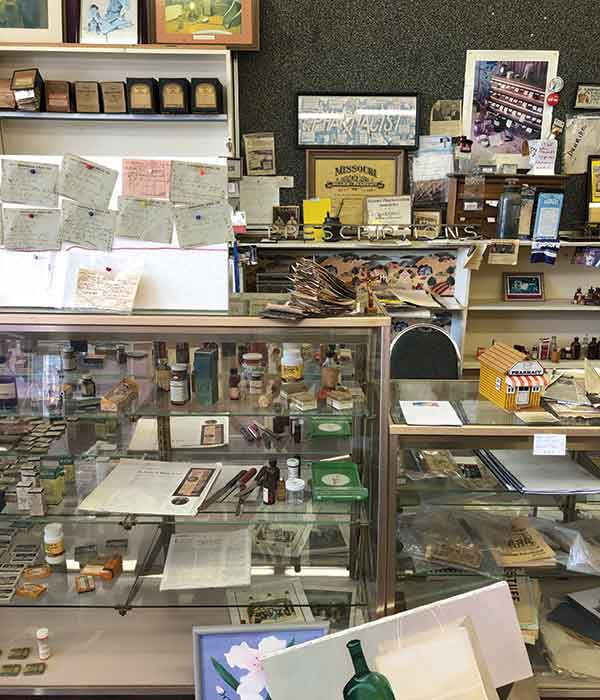
It’s not just pharmacy relics, though. Keith has also put together a Rotarian corner, a Cardinals baseball corner, a veteran’s and military corner, a Masonic corner, and a Sheryl Crow corner to honor the town’s celebrity pop star. The Mitchell’s kids played with Sheryl when they were growing up.
Keith, ninety-two, says to “just call” to see if his museum is open. The phone number is on the window of the drugstore. Robbin, 75, will keep posting local history pieces, including old newspaper articles and photos, some from the late 1800s, as she finds them.
“People have just gone really crazy about it,” she says. “I like history. It has kept my mind off the pandemic for the past six months. I think it has helped everybody else, too.”
MID-MISSOURI VACUUM
410 S. Bishop Ave., Rolla • 573-261-9577 • 9 am‒5 pm Mondays–Fridays, Saturdays 9 am‒2 pm (call to verify) and by appointment • Free
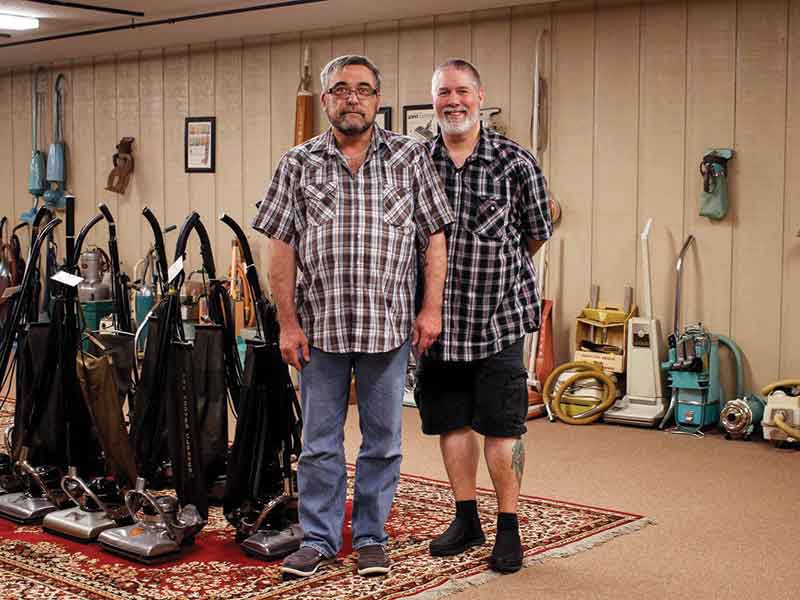
Tom Gasko’s collection of 550 vacuums ranges from more modern models to true antiques dating to the 1870s. His fascination started in earnest when he discovered a discarded General Electric Roll-Easy as he walked to school one morning.
“I grabbed the hose and the pieces and rolled it back home,” Tom recalls. “My mother had a fit. Then she had to drive me to school. I thought about that turquoise-colored vacuum cleaner all day.”
He was in kindergarten. Six years old. When Tom got home from school, he plugged in the vacuum cleaner. And the lights went out.
“My mother was not having any of it,” he says, remembering waiting in the darkness for his father to come home on that day in 1967. Instead of delivering wrath, his father was amused and changed the blown-out fuse to restore the lights. Tom watched his dad disassemble the old vacuum, locate the wiring issue, and repair it.
“I flipped the switch and it ran,” Tom says. “And it still does.”
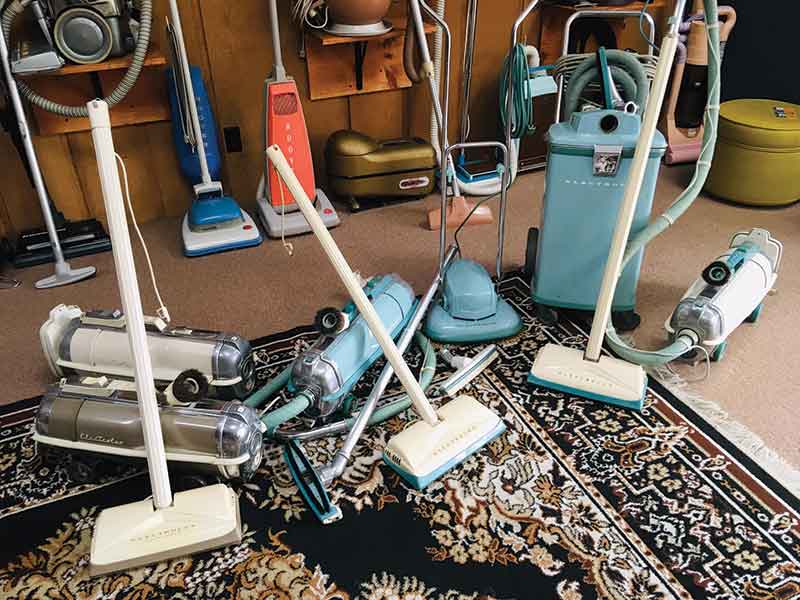
The old vacuuming beauty is on display at Mid-Missouri Vacuum in Rolla. There’s no charge to see the vacuum cleaner collection. If Tom doesn’t have a customer for service, sales, or repair, he’ll have more time to show the entire collection. Otherwise, the Wall of Fame, “the best of the best,” is for browsers to view. Those who make an appointment can get a 60-minute tour of the inner sanctum where hundreds of machines are segregated by decade. Many of the vacuum cleaners also display the advertising that hawked the products.
Tom is brimming with knowledge about the historical significance of vacuum cleaners: they were the first appliance to have a cord. Homes with the first electric lights had no receptacles for plugs. Instead, the end of the vacuum cord connected to the light socket. Plug-ins weren’t in wide use until the 1920s when General Electric invented the electric iron. Tom has one of those light-socket vacuum models on display.
Tom, who also collects the owner’s manuals, organized and hosted a COVID-safe vacuum collector’s convention last September.
USS ARIES HYDROFOIL MUSEUM
1495 Corp RD., Gasconade • 636-541-6130 or 314-550-0931 • Open most weekends and by appointment • Donations accepted • USSaries.org
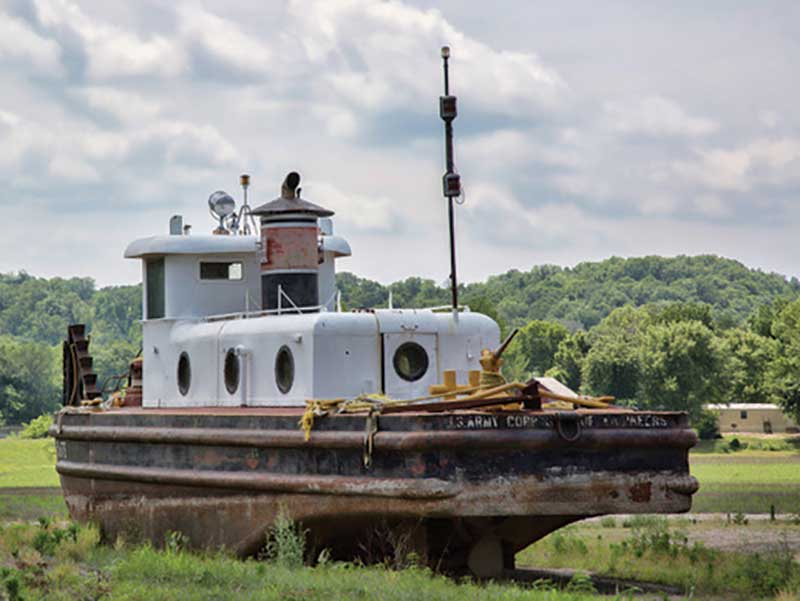
When the US Navy downsized its 600-ship fleet by 250 in the mid-1990s, its entire fleet of six Pegasus-class hydrofoil missile boats were decommissioned. Four were scrapped for parts and metal. One was stripped to her hull and rebuilt as a yacht.
Only one remained intact, and it’s the namesake of the USS Aries Hydrofoil Museum, an outdoor venue in rural Gasconade County at the confluence of the Gasconade and Missouri rivers. The collection, owned by Eliot James and Bill and Bob Meinhardt, has grown and now includes President Richard Nixon’s Volga, a gift from former Soviet Communist Party leader Leonid Brezhnev.
The hydrofoil operates like an airplane, Eliot explains. “The foils are basically wings—they stay in the water— and as the vessel moves forward, it lifts the hull out of the water. The only thing still in the water is the wings.” Others have described the experience as “exactly like flying something the equivalent of a 747 just 15 feet above the water.”
The Aries could transport 23 seamen, eight harpoon missiles, and a cannon. It’s big: 133 feet long with the foils down, 28 feet wide, and 250 tons. And how does one come to own a decommissioned Navy hydrofoil? Eliot and the Meinhardts teamed up to purchase the USS Aries for scrap; they put in a successful bid of about $37,500—a nickel a pound. The scrap value was remarkably higher, Eliot says. They saw the ship in the Norfolk, Virginia, shipyard, and based on its “very good condition,” they made a deal with the company that purchased the other hydrofoils to acquire parts to refit the Aries “and make her travel again.” They still weren’t sure how to operate a hydrofoil at this point.
Four months later, still in Charleston, South Carolina, where the Aries was towed from Norfolk, an epic adventure was about to begin on less than a shoestring budget.
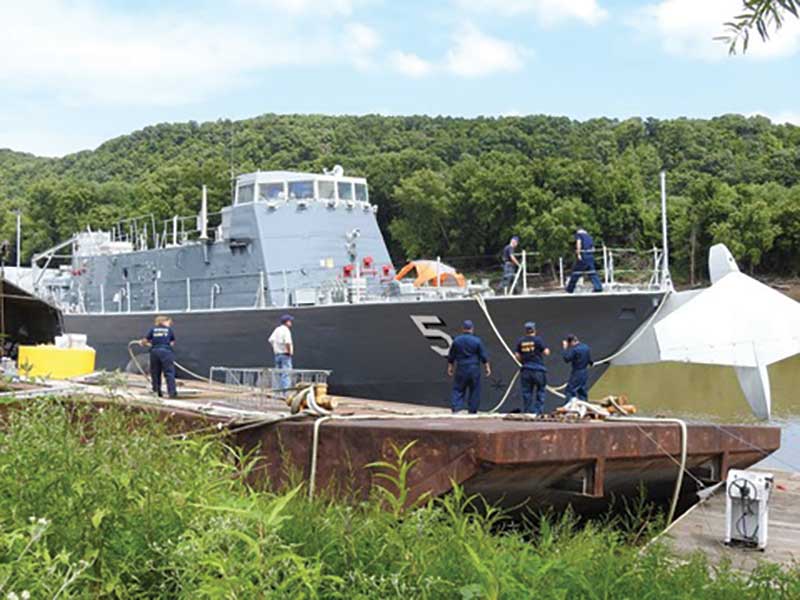
“It was time for us to leave,” Eliot says, estimating a low six-figure price tag for the restoration work, though the Aries was not in flying condition. They’d planned to hire a crew to sail the ship to Missouri via the intercoastal waterway, Florida Keys, Gulf of Mexico, then upriver to the heartland. “We had no big water experience,” he says. “But we were broke. We decided we would just start on our way, and if we needed help, we’d hire a crew.”
The roughly 2,500-mile journey took 45 days. The museum has 501(c)(3) status, which makes it eligible for the federal ship donation program and getting parts from the Navy. All donations to the museum are tax-deductible.
The museum’s fleet now includes the Aries, three Dynafoils, a Water Spyder, the Volga, a HI-Foil, and the US Naval research ship FRESH-1.Several are restored to flying condition, but there’s still “a significant amount of money” needed to make the Aries’s foils operational.
“We’re hopeful,” Eliot says. “Our intention is to get the Aries back in flying condition and take her to other maritime museums and be a traveling exhibit.”
MORE MUSEUMS
GRAND RIVER HISTORICAL SOCIETY MUSEUM
1401 Forest Dr., Chillicothe • Open year-round, 1–4 pm • Saturdays, Sundays, and Wednesdays • Closed Easter and Christmas • Tours by appointment • 660-646-1341 • Free • ChillicotheMuseum.comChillicothe promotes itself as “the home of sliced bread,” and the local museum, 25 miles south of Trenton and 90 miles northeast of Kansas City, has “the original sliced bread machine” on display. The museum also has a particularly COVID-friendly option for guests: Cell phone tours. Dial 660-240-3001 and follow the instructions to “see” all the exhibits or just particular sections.
LEILA’S HAIR MUSEUM
1333 S. Noland Rd., Independence • 9 am–4 pm Tuesdays–Saturdays • 816-833-2955 • $15 for adults; kids under 12, adults 65 and older, and military with ID are $7.50 • LeilasHairMuseum.net
Hair today, gone tomorrow. This fascinating museum is devoted entirely to the art and history of hair: jewelry and wreaths all made out of human hair, as well as pieces containing hair from Queen Victoria, four presidents, and multiple celebrities, ranging from Michael Jackson to Marilyn Monroe.
MISSOURI PRESS ASSOCIATION PRINT SHOP MUSEUM
310 Main St., Arrow Rock • Call for hours • 660-837-3231 • Donations accepted • MoPress.com/mpa-museum
The museum is located in the Odd Fellows Lodge Building and has a variety of letterpress printing equipment on display, including Linotype, a newspaper flatbed press, and other tools of the printing trade. Featured: the oldest known George Washington hand press in North America.
NATIONAL COOKIE CUTTER HISTORICAL MUSEUM
504 S. Schifferdecker Ave., Joplin • Inside the Joplin Museum Complex • 10 am–4 pm Tuesdays–Saturdays • 417-623-1180 • $3; kids 12 and under free • CookieCutterCollectorsClub.com
The country’s progression from wood to tin to aluminum to plastic is a history on display at the National Cookie Cutter Museum inside the Joplin History and Mineral Museum. The cookie cutter museum offers both a trip back in time as well as a complementary cookie cutter. The museum furnished more than 600 free cookie cutters to school kids last spring, says co-curator Kay Johnson.
The National Cookie Cutter Historical Museum is supported by the Cookie Cutter Collectors Club but is a separate entity from the museum complex. The cookie cutter displays – 12, six-foot tall cases – are accompanied by an archive of cookie cutter-themed ephemera: newsletters, old advertisements, and similar relics.
RALPH FOSTER MUSEUM AT COLLEGE OF THE OZARKS
1 Cultural Ct., Point Lookout • 9 am–5 pm Mondays–Fridays • 417-690-3407 • Adults $8, senior and group rate $6, veterans $5, high school age and under free • RFosterMuseum.com
The original jalopy from The Beverly Hillbillies television comedy is on display here. The museum is primarily devoted to Ozarks history, with colorful and educational exhibits of old schools, American bison, natural history, antique clocks and pocket watches, gems, and notable personalities.
TRAIL OF TEARS STATE PARK
Visitor’s Center • 429 Moccasin Springs, Jackson • Closed during COVID-19 • 573-290-5268 • Free • MoStateParks.com/park/trail-tears-state-park
You might be surprised to find unique museum-quality exhibits and educational displays just a short drive away. Missouri’s state parks and Conversation Nature Centers have standing and rotating displays that are worth checking out.
The visitor’s center at Trail of Tears State Park near Jackson is one such gem. A visually stunning, standing exhibit tells the sad tale of the thousands of Cherokee Indians who died on a forced march to Oklahoma during harsh winter conditions in 1838 and 1839.
Be sure to also visit nearby Bollinger Mill State Historic Site, 113 Bollinger Mill Road, Burfordville. 573-243-4591
RETROGRADE
112 W. Gay St., Warrensburg • Closed until further notice due to COVID-19 • [email protected] • Donations accepted • RetrogradeMuseum.org
Retrograde has thousands of toys, collectibles, and games, including more than a thousand arcade games and multiple arcade machines, pinball machines, and board games. The museum also partners with local schools for multiple programs and is teaching chess at four Warrensburg-area elementary schools.
WORLD’S LARGEST SMALL ELECTRICAL APPLIANCE MUSEUM
51 Highway 59, Diamond (inside JR’s Western Store) • Open by appointment • 417-793-7936 • Call for details • WorldsLargestSmallelEctricalApplianceMuseum.com
GOLDEN PIONEER MUSEUM
35930 State Highway 86, Golden • April 12–October 31, 10:30 am–4:30 pm Tuesdays–Saturdays • 417-271-3300 • Free • GoldenPioneerMuseum.org
STARS AND STRIPES MUSEUM AND LIBRARY
17377 Stars and Stripes Way, Bloomfield • Call for hours • 573-568-2055 • Donations • Facebook.com/nationsmilitarynewspaper
Photos // Nicholas-Beazley Aviation Museum, Downing House Museum, Boles Fire History Museum, Mitchell Pharmacy Museum, Mid Missouri Vacuum, Kathy Lewis, USS Aries Hydrofoil Museum
Related Posts
Revitalizing Missouri Downtowns
Here’s how Missourians are working together to revitalize downtowns across the state.
Columbia’s Museums Will Amaze
Boost your cultural IQ and have a great time while doing it at Columbia’s museums.
Paddling 340 Miles on the Missouri River
From August 8 to 11, 450 crazy people will paddle down the Missouri River in canoes, in kayaks, and stand-up paddleboats—all competing against each other and themselves in the MR340 race.


